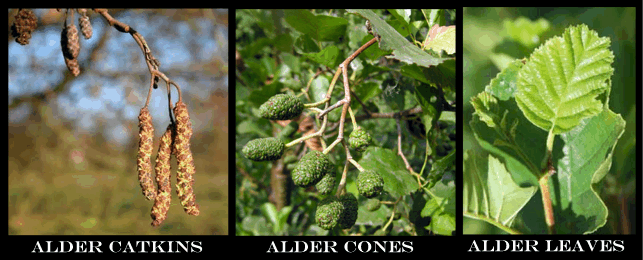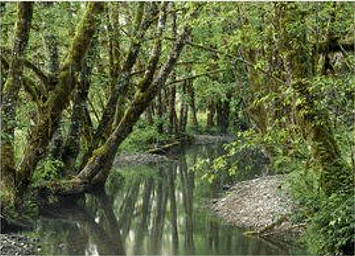
The European Alnus glutinosa or Alder is one of the several common and native trees to be found on Dartmoor and the name has derived from the Anglo Saxon word – alor which in a roundabout way means red or brown. Other local names for the tree are Aller, Aller Bush and Whistlewood. Alder woods are often found where the ground is waterlogged which in the case of Dartmoor means the wet woodlands which are often found in association with oak woods or Rhôs pasture which occur in the valley systems. Such places are also known as alder carrs and once again refer to the waterlogged wooded terrain that, typically, represents a succession stage between the original reedy swamp and the eventual formation of forest.
One typical trait of alder trees is that they help prevent soil erosion thanks to their closely interlaced roots. In addition alder is especially associated with a nitrogen-fixing bacterium called Frankia alni. This bacterium is found in the root nodules and has the ability to absorb nitrogen from the air and makes it available to the tree. By giving this service, the alder in return provides the bacterium with sugars, which it produces through photosynthesis. Thanks to this partnership one of the benefits provided by alder trees is the ability to improve the fertility of the soil, the nitrogen which they produce also proves beneficial for any other tree species which may follow.
The tree is one of the more easier trees to recognise due to its distinctive little fruiting body, called a strobile. These are visible in the autumn and have the appearance of 1-inch long cones. Strobiles remain on the tree until the following spring. Due to the fact that they are present throughout the winter these small, nutlike seeds provide a source of winter food for birds and small mammals. The alder also has very distinctive leaves which are oval with distinctive veins which run down the centre of the leaf. From the central vein a network of side veins run the the outer edge of the leaf. The egg-shaped leaves have serrated edges and distinct veins. A central vein runs down the centre of the leaf and a series of side veins run from the central vein to the outer edge, angled toward the leaf tip In addition the alder has both female and male leaves, the former can be seen at the end of the leaves whilst the latter appear as catkins.

The living wood of an alder is naturally a pale colour but when cut it takes on a deep orange or reddish colour hence the red reference in the trees name. Once cut and away from its watery habitat the timber rots very easily which makes it useless for building purposes. But when underwater the wood remains useful for shoring up the sides of rivers and canals as it does not rot.
When used for burning alder gives off a lot of heat but when wet the benefit of this is negated by the amount of smoke emitted. However, alder has its other uses, the main one being that it makes excellent slow burning charcoal and is easily coppiced. Therefore it is not unusual to see small stands of alder around factories which produced gunpowder such as that at Powder Mills near Postbridge. One of the reasons for choosing this site was that it provided scope for planting alder trees that could be used to produce the charcoal and additionally provide a wind break. On Dartmoor alder was also a popular wood for making tool handles and other domestic items. In 1910 a newspaper article reported that; “On Dartmoor alder is much used for tool handles etc.: Old John French, of Dunnabridge Pound, who assisted to quarry the stone when Dartmoor War Prisons were first built, used to say – “When the aller leaf is a big as a penny, the stick will wear as tough as any.” – The Torquay Times, November 18th, 1910.
Other uses of the alder tree was that in natural dye making, for instance the bark makes a reddish dye known as Aldine Red. Also the bark when mixed with young shoots produces a yellow dye whilst the fresh shoot alone will produce a cinnamon colour. The actual wood itself is capable of producing a pinky fawn dye and the catkins a green dye (which some folk believe the piskies used for dying their clothes green which acted as a camouflage).

Medicinally the prime use of alder bark is to make a deconcoction which when applied externally will reduce any swelling or inflammation as well as supposedly help treat various skin complaints. When boiled in vinegar the bark produces a liquid that has many healing powers, it is said to kill head lice and sooth itching and heal the scabs caused by the lice. When used as a mouth gargle it is said to cure toothache as well as cleaning the teeth and strengthening the gums, some folk would even use it to ease a sore throat and laryngitis. Alder cones are highly astringent and various potions and lotions made from these were used to staunch heavy bleeding and as providing relief from diarrhoea or indigestion. A more complicated cure for gastric worms was to mix the berry juice with cider and administer it on the night of a full moon, this process must be repeated at the coming of the next full moon for the cure to be 100% effective.
As far as folklore and superstition go the alder tree has always been regarded as a tree of evil descent. There is not true reason for this apart from the fact that its natural habitat is that of dark, swampy woodlands which generally attracted a great degree of superstition. However there are a few saving graces attached to alder in the realms of folklore, for instance some would have you believe that if you carried a piece of alder wood in your pocket you would never suffer from the rheumatics. Others will tell you that if you spread alder leaves in a room it will never be plagued by flies. Some furniture makers suggested that secreting some alder wood in your furniture would lure out the woodworm who apparently favoured it as a place top lay their eggs.
There are several place-names of Dartmoor which indicate the presence of Alder trees; Alder Wood (SX 789774). Alderpark Copse (SX 7840 8967). In addition there are some place-names with the ‘aller’ element such as:- Aller (SX 7434 8318 & SX 8090 8011), the Aller Brook; (SX 675 714), and Aller Clauns (SX 5160 8105).
 Legendary Dartmoor The many aspects past and present of Dartmoor
Legendary Dartmoor The many aspects past and present of Dartmoor
